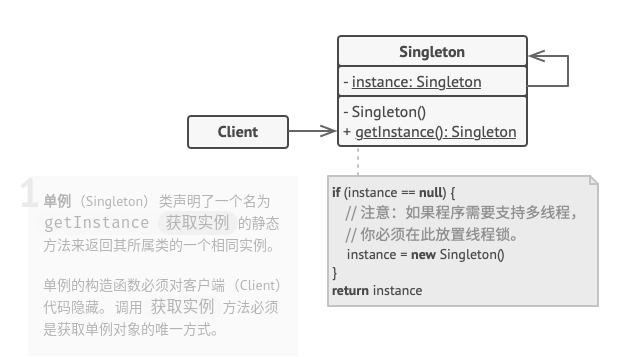单例模式
简介

你能在电脑上调出两个Windows任务管理器吗?假设能,如果两个管理器显示的数据相同,那何必要存在两个呢?如果两个管理器显示的数据不同,那我该相信哪一个呢?
单例模式:确保一个类只有一个实例,并提供一个全局访问点来访问这个唯一实例。
它的三个要点分别为:
- 这个类只能有一个实例
- 它必须自己创建这个实例
- 它必须自己向整个系统提供这个实例
结构

实现
// singleton.h
#ifndef __SINGLETON_H__
#define __SINGLETON_H__
#include <iostream>
#include <string>
#include <thread>
#include <chrono>
#include <mutex>
#include <pthread.h>
#include <unistd.h>
// 单线程版本
class Singleton {
public:
static Singleton* getInstance() { // 提供外部接口,满足了第三个要点
if(instance == nullptr) {
std::cout << "New Singleton" << std::endl;
instance = new Singleton();
}
return instance;
}
private:
Singleton(){} // 构造函数是私有的,即只能在类内部实例化,满足了第二个要点
static Singleton* instance; // instance是static的,满足了第一个要点
};
Singleton* Singleton::instance = nullptr;
// 线程安全的多线程版本
class SingletonA {
public:
static SingletonA* getInstance() {
if(instance == nullptr) {
m_mutex.lock(); // 添加互斥锁
// std::lock_guard<std::mutex> lock(m_mutex);
if(instance == nullptr) {
std::cout << "New SingletonA" << std::endl;
instance = new SingletonA();
}
m_mutex.unlock();
}
return instance;
}
private:
SingletonA() {}
static SingletonA* instance;
static std::mutex m_mutex;
};
SingletonA* SingletonA::instance = nullptr;
std::mutex SingletonA::m_mutex;
#endif //__SINGLETON_H__
// main.cpp
#include "singleton.h"
void* CallSingleton(void *arg) {
Singleton::getInstance();
std::cout << "num: " << arg << std::endl;
return nullptr;
}
void* CallSingletonA(void *arg) {
SingletonA::getInstance();
std::cout << "num: " << arg << std::endl;
return nullptr;
}
int main(int argc, char *argv[]) {
CallSingleton(0);
CallSingleton(0);
CallSingletonA(0);
CallSingletonA(0);
// Windows
std::thread t1(CallSingleton);
std::thread t2(CallSingleton);
t1.join();
t2.join();
// Linux
// pthread_t tid[2];
// pthread_create(&tid[0], NULL, CallSingleton, NULL);
// pthread_create(&tid[1], NULL, CallSingleton, NULL);
return 0;
}
# singleton.py
from threading import Thread, Lock
# 单线程版本,使用元类
class SingletonMeta(type):
_instance = {}
def __call__(cls, *args, **kw):
if cls not in cls._instance:
instance = super().__call__(*args, **kw)
cls._instance[cls] = instance
return cls._instance[cls]
class TestSingleton(metaclass=SingletonMeta):
def some_business_logic(self):
# ...
pass
# 线程安全的多线程版本,使用元类
class SingletonMateA(type):
_instance = {}
_lock: Lock = Lock()
def __call__(cls, *args, **kw):
with cls._lock:
if cls not in cls._instance:
instance = super().__call__(*args, **kw)
cls._instance[cls] = instance
return cls._instance[cls]
class TestSingletonA(metaclass=SingletonMateA):
value :str = None
def __init__(self, value: str) -> None:
self.value = value
def some_business_logic(self):
# ...
pass
def TestTestSingletonA(value: str) -> None:
rsa = TestSingletonA(value)
print(rsa.value)
if __name__ == "__main__":
#
s1 = TestSingleton()
s2 = TestSingleton()
if id(s1) == id(s2):
print(id(s1))
else:
print(id(s1), id(s2))
#
process1 = Thread(target=TestTestSingletonA, args=("FOO",))
process2 = Thread(target=TestTestSingletonA, args=("BAR",))
process1.start()
process2.start()
实例
问题描述
总线是计算机各种功能部件或者设备之间传送数据、控制信号等信息的公共通信解决方案之一。现假设有如下场景:某中央处理器(CPU)通过某种协议总线与一个信号灯相连,信号灯有64种颜色可以设置,中央处理器上运行着三个线程,都可以对这个信号灯进行控制,并且可以独立设置该信号灯的颜色。抽象掉协议细节(用打印表示),如何实现线程对信号等的控制逻辑。
问题解答
加线程锁进行控制,无疑是最先想到的方法,但各个线程对锁的控制,无疑加大了模块之间的耦合。较好的方法是使用单例模式:
# example.py
# encoding=utf8
import threading
import time
# 这里使用方法__new__来实现单例模式
class Singleton(object): # 抽象单例
def __new__(cls, *args, **kw):
if not hasattr(cls, '_instance'):
orig = super(Singleton, cls)
cls._instance = orig.__new__(cls, *args, **kw)
return cls._instance
# 总线
class Bus(Singleton):
lock = threading.RLock()
def sendData(self, data):
self.lock.acquire()
time.sleep(3)
print("Sending Signal Data...", data)
self.lock.release()
# 线程对象,为更加说明单例的含义,这里将Bus对象实例化写在了run里
class VisitEntity(threading.Thread):
my_bus = ""
name = ""
def getName(self):
return self.name
def setName(self, name):
self.name = name
def run(self):
self.my_bus = Bus()
self.my_bus.sendData(self.name)
if __name__ == "__main__":
for i in range(3):
print("Entity %d begin to run..." % i)
my_entity = VisitEntity()
my_entity.setName("Entity_"+str(i))
my_entity.start()
总结
优点
- 保证一个类只有一个实例,可以节省较多的内存空间。
- 为实例提供一个全局访问点,可以更好地进行数据同步控制,避免多重占用。
- 可以常驻内存,可以减少系统开销。
缺点
- 该模式同时解决了两个问题(保证一个类只有一个实例、为实例提供一个全局访问点),违反了单一职责原则。
- 多线程下需要考虑线程安全机制。
- 单例模式没有抽象层,不方便扩展。
场景
- 生成全局惟一的序列号。
- 访问全局复用的惟一资源,如磁盘、总线等。
- 单个对象占用的资源过多,如数据库等。
- 系统全局统一管理,如
Windows下的Task Manager。 - 网站计数器。
与其他模式的关系
- 外观模式类通常可以转换为单例模式类,因为在大部分情况下一个外观对象就够了。
- 如果你能将对象的所有共享状态简化为一个享元对象, 那么享元模式就和单例模式类似了。 但这两个模式有两个根本性的不同。
- 只会有一个单例实体, 但是享元类可以有多个实体, 各实体的内在状态也可以不同。
- 单例对象可以是可变的。 享元对象是不可变的。
- 抽象工厂模式、 生成器模式和原型模式都可以用单例模式来实现。